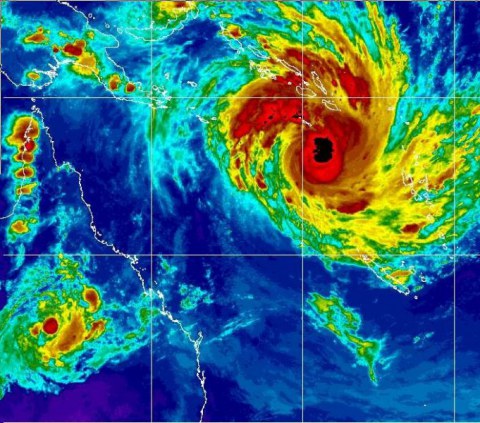Tropical Cyclone Yasi may become Queensland's second extreme weather disaster within a month, with the potential to rival the destructive power of Hurricane Katrina that destroyed New Orleans in 2005. Cyclone Yasi is likely to hit the Queensland coast as a Category 4 storm with winds of 250-260 km per hour on late Wednesday or early Thursday.
Everyone thought the Queensland floods and the flooding of Brisbane was enough of a disaster to deal with. Certainly the people of Queensland don't need any more trouble this year.
But this is cyclone season, and there are more cyclones generated in La Niña years, and this is a particularly strong La Niña.
Add to that higher global atmospheric temperatures enabling increased water carrying capacity and record sea surface temperatures around Australia and in the coral sea increasing cyclone intensity and you have the makings of a second extreme weather event of disasterous proportions to be unleashed on Queensland.
The tropical cyclone is forecast to hit the Queensland coast betwwen Innisfail and Mackay on Wednesday or Thursday with winds up to 250 kph as a category 4 or even a category 5 cyclone. As of 4pm Monday the cyclone is classified as category 3 with wind gusts up to 185 kilometres per hour and will intensify as it moves over the warm waters of the Coral Sea. The Bureau of Meteorology has issued a Cyclone WATCH for coastal and island communities from Cooktown to Yeppoon.
Cyclone Yasi will follow ex-cyclone Anthony, which was downgraded to a tropical front as it crossed the coast near Bowen on Sunday bringing rainfalls of up to 300mm in the Mackay area. So we have some water catchments now soaked awaiting the arrival of Cyclone Yasi. The high potential for flooding and flash flooding, as well as the destruction and havoc from high speed winds and 4 metre storm surges spells another potential disaster.
South east Queensland and Brisbane are not directly in the cyclone's path but will probably experience rain from the fringe of Yasi. Authorities are currently modeling and debating whether to release water from Wivenhoe Dam to less than 100 per cent capacity to allow for greater flood control capability with some hydrologists warning without a release Brisbane may be in danger of another flood if another extreme rainfall event happens in the catchment. (The Australian: Fears full dam will cause new flooding in Brisbane)
Two cyclones tracking the same path within days of each other is very unusual according to weather forecasters. It is the stuff of nightmares made more likely in a warming world.
Queensland Premier Anna Bligh told the ABC "[Yasi] may well be one of the largest and most significant cyclones that we have ever had to deal with," Ms Bligh said. "This is an event we have to take seriously. I know cyclones can at the last minute turn off the coast, and I certainly hope this one does. But the bureau advises me in the most serious terms, that all of the modelling right now says this is going to cross our coast."
The cyclone could bring a 4 metre storm surge destroying boats, houses and low lying coastal infrastructure. Evacuations of waterfront properties has been ordered. All ports from Cairns to Mackay are closing Tuesday in anticipation of the storm.
Residents who are staying are advised to lock down any loose items, and have stocks of food and water for at least 72 hours, and stock up on torches, battery-operated radios, medicine, fuel, first-aid and monitor weather alerts.. For more information visit Emergency Management Queensland: Cyclone
A similar storm, Cyclone Larry, caused one billion dollars worth of damage in 2006 and increased the price of bananas to $14 a kilogram everywhere in Australia.
Yashi will further disrupt coal mining and export. But of greater concern, but hardly mentioned by others, is the impact on agriculture and food production following on from the havoc wreaked by the widespread flooding in December. Food prices for tropical produce can be expected to spike which comes hard on the heals of fruit and vegetable prices increasing due to widespread flood damage in Queensland, Victoria and New South Wales.
Climate scientists have been telling us that when you warm the climate you get storms with greater frequency and intensity. We are witnessing the results of global warming with Cyclone Yasi.
And we argue about a one year flood levy, when perhaps we need to consider phasing out the subsidies for fossil fuels and the carbon polluters and putting this money into a disaster relief fund to help adapt and recover from such extreme weather related events which are only going to happen on a more frequent basis with global warming.
Stay safe Queenslanders.
Sources:


Comments
Re: Cyclone Yasi spells disaster for flood ravaged Queensland
A devastating cyclone hit people of Northeastern Australia. Cyclone Yasi is still around Australia. Queensland, the state of Australia which makes up the northeast quarter of the continent, is bracing for the impact of Cyclone Yasi. I found this here: Queensland coast of Australia braces for Cyclone Yasi Yasi is a tropical storm heading for the already battered state of Queensland, which not too long ago encountered a number of the worst flooding on record. Yasi is approximately identical in dimensions and power as Katrina, which battered the Gulf Coast of the United States in 2005.